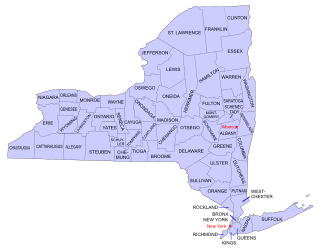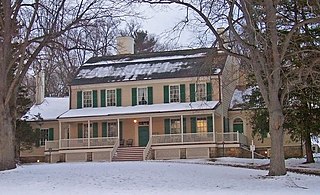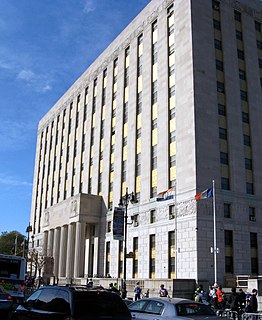
Edward Durell Stone was an American architect known for the formal, highly decorative buildings he designed in the 1950s and 1960s. His works include the Museum of Modern Art, in New York City, the United States Embassy in New Delhi, India, The Keller Center at the University of Chicago, and the John F. Kennedy Center for the Performing Arts in Washington, D.C.

Bedford is a town in Westchester County, New York, United States. The population was 17,335 at the 2010 census.

Bedford Hills is a hamlet and census-designated place in the Town of Bedford, Westchester County, New York, United States. The population was 3,001 at the 2010 census. The Bedford Hills Correctional Facility for Women is located in the hamlet.

The Croton Aqueduct or Old Croton Aqueduct was a large and complex water distribution system constructed for New York City between 1837 and 1842. The great aqueducts, which were among the first in the United States, carried water by gravity 41 miles (66 km) from the Croton River in Westchester County to reservoirs in Manhattan. It was built because local water resources had become polluted and inadequate for the growing population of the city. Although the aqueduct was largely superseded by the New Croton Aqueduct, which was built in 1890, the Old Croton Aqueduct remained in service until 1955.

Buildings, sites, districts, and objects in New York listed on the National Register of Historic Places:

Saint Paul's Church National Historic Site is a United States National Historic Site located at 897 South Columbus Avenue in Mount Vernon, New York, just north of the New York City borough of The Bronx. The site was authorized in 1978 to protect Saint Paul's Church from increasing industrialization of the surrounding area. Saint Paul's Church is one of New York's oldest parishes and was used as a military hospital after the American Revolutionary War Battle of Pell's Point in 1776. The 5-acre (20,000 m2) cemetery surrounding the church is also within the historic site and contains an estimated 9,000 burials dating from 1704.

The John Jay Homestead State Historic Site is located at 400 Jay Street in Katonah, New York. The site preserves the 1787 home of statesman John Jay (1745-1829), one of the three authors of The Federalist Papers and the first Chief Justice of the United States. The property was designated a National Historic Landmark in 1981 for its association with Jay. The house is open year-round for tours.

Usonia Historic District was a planned community and is now a national historic district located in Town of Mount Pleasant, adjacent to the village of Pleasantville, Westchester County, New York. In 1945, a 100-acre (0.40 km2) rural tract was purchased by a cooperative of young couples from New York City, who were able to enlist Frank Lloyd Wright to build his Broadacre City concept. Wright decided where each house should be placed. Wright designed three homes himself and approved architectural plans of the other 44, which were designed by such architects as Paul Schweikher, Theodore Dixon Bower, Ulrich Franzen, Kaneji Domoto, Aaron Resnick and David Henken – an engineer and Wright apprentice.

The Architecture of Buffalo, New York, particularly the buildings constructed between the American Civil War and the Great Depression, is said to have created a new, distinctly American form of architecture and to have influenced design throughout the world.

Yorktown Heights station is a former railroad station on the Putnam Line in Yorktown Heights, New York, United States. It is a wooden building located on Commerce Street at the intersection of Underhill Avenue in Railroad Park.

The Bronx County Courthouse, also known as the Mario Merola Building, is a historic courthouse building located in the Concourse and Melrose neighborhoods of the Bronx in New York City. It was designed in 1931 and built between 1931 and 1934. It is a nine-story limestone building on a rusticated granite base in the Art Deco style. It has four identical sides, an interior court, and a frieze designed by noted sculptor Charles Keck. The sculptures on the 161st Street side are by noted sculptor George Holburn Snowden. Two sculptural groups on the Walton Avenue side are by noted sculptor Joseph Kiselewski. The Bronx Museum of the Arts was once located on the main floor. The building stands two blocks east-southeast of Yankee Stadium, and across 161st Street from Joyce Kilmer Park.

The A. Conger Goodyear House is an NRHP listed historic home located at Old Westbury in Nassau County, New York.

The Bedford Village Historic District is a national historic district in Bedford, Westchester County, New York. The district contains 80 contributing buildings and one contributing site. It encompasses most of the original 1680 hamlet and is laid out in a typical village green plan. Notable buildings include the court house (1787), library (1807), school house (1829), post office, and Presbyterian church (1872). The buildings are good examples of the Greek Revival and Gothic Revival styles. Two of the buildings are now museums.

Palmer-Lewis Estate is a historic estate and national historic district located at Bedford, Westchester County, New York. The district contains 12 contributing buildings, one contributing site, and four contributing structures. It includes the main house, 15 farm-related outbuildings, and landscape features such as stone walls, walled fields, the remains of an orchard and vegetable garden, a barnyard complex, and the ruins of a dairy barn. The main house is a late 18th-century residence redesigned about 1860 in the Italianate style.

Woman's Club of White Plains, originally known as the Thomas H. Kerr residence, is a historic clubhouse located at White Plains, Westchester County, New York. It was built in 1910 as a residence and enlarged in 1932, after being acquired as a clubhouse for the Contemporary Club. McKim, Mead and (Sanford) White were the architects of this property, which originally had 41 acres, including a small farm and extensive orchards. It is a two-story, stuccoed, poured concrete building in the Italian Renaissance Revival style. It features a broad hipped roof, deep overhanging eaves, and prominent brick chimneys. It has large glass-enclosed porches at each end of the house.

Soundview Manor is a historic home located on four acres in White Plains, Westchester County, New York. Built in 1920 by landowner Robert B. Dula, and is a stuccoed, frame building in the Classical Revival style. It is "L"-shaped and has a three-story, three-bay central section flanked by two-story, one-bay blocks on each side. The house has flat roofs, with prominent balustrades. The flat roofed front porch is supported by Tuscan order columns.

Rye Meeting House, also known as Milton Mission Chapel, Grace Chapel, and the Friends Meeting House, is a historic Quaker meeting house located at Rye, Westchester County, New York. The property is adjacent to the Bird Homestead. It is a one-story, wood frame building on a stone foundation with two main volumes, a nave and an asymmetrical transept. The exterior is sheathed in clapboard and shingles and exhibits characteristics of the Stick style. The front facade features a 2 1/2-story bell tower. The building was built in the 1830s as a school house. It was moved to its present site in 1867, and enlarged in 1871, 1875, and 1877. At the time, the church was a mission church of nearby Christ's Church, an Episcopal church. The Quakers obtained the property in 1959. The property was deeded to the city of Rye in 2002.

Presbyterian Rest for Convalescents, also known as the Y.W.C.A. of White Plains and Central Westchester, is a historic convalescent home located at White Plains, Westchester County, New York. It was built in 1913, and is a 3 1/2-story, "H"-shaped building in the Tudor Revival style. The two lower stories are in brick and the upper stories in half-timbering and stucco. It has a tiled gable roof with dormer windows. The section connecting the two wings includes the main entrance, which features stone facing and Tudor arches. The connected Acheson Wallace Hall was built in 1972. The building housed a convalescent home until 1967, after which it was acquired by the Y.W.C.A. and operated as a residence for women.

The Dr. James Patrick House is a historic house at 370 North Williams Drive in Fayetteville, Arkansas. Set on a steeply pitched lot on Mount Sequoyah, it is a basically linear single-story structure sited well away from the road to maximize its eastward view. It has a low-pitch roof and is finished in glass and brick. It is functionally divided by a carport near its center, with public rooms on one side and private ones the other. It was built in 1965-66 to a design by Ernie Jacks, who had previously worked with Edward Durell Stone. It is a distinctive local example of Mid-Century Modern architecture, in a neighborhood principally populated with more conventional vernacular buildings of the period.

The Bedford Presbyterian Church is a parish church in Bedford, Westchester County, New York. It was built in 1872 in the Gothic Revival style, as the fourth building for the congregation on the site. The historic building is part of the Bedford Village Historic District, and was listed in 1973. It also serves as a venue for performances of sacred music.
























